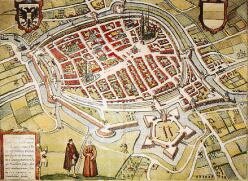Opgevist uit Alva's gracht

6 maart t/m 30 augustus 2009
Hoe zagen de Groningers er vijfhonderd jaar geleden uit? Opgegraven textiel bij de huidige Prinsenstraat in Groningen, zoals handschoenen, kousen, hoeden en mutsen, geven inzicht in wat burgers, arbeiders en kinderen droegen in het 16e-eeuwse Groningen.
Bij opgravingen in 1996 en 2000 in de Groningse Prinsenstraat zijn opvallend veel textielfragmenten gevonden. Door de voorgeschiedenis van deze plek zijn de stukken te dateren omstreeks het midden van de 16e eeuw. Een unieke vondst, omdat er nauwelijks fragmenten van burgerkleding uit die tijd in Nederland bestaan. Op de bescheiden tentoonstelling kunnen bezoekers zich aan de hand van deze vondsten een beeld vormen van wat Groningers droegen tussen 1550 en 1600. Deze expositie kwam tot stand in samenwerking met Dr. Hanna Zimmerman. Zij conserveerde en onderzocht de gevonden textielfragmenten. In 2007 resulteerde dat in een proefschrift.

